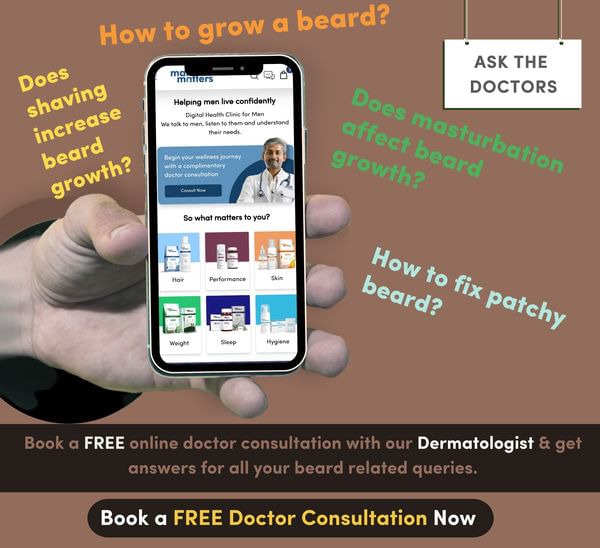How to Increase Testosterone Level for Beard Growth?
Are you struggling with growing your beard? Wondering how to increase testosterone level for beard growth? Keep scrolling to know more!

Watching a beard grow can be like watching grass grow. It can be frustrating if you're trying to grow a full beard.
The younger you are, the longer it may take you to reach your beard goals. Most men begin growing facial hair during puberty. Some men sport the beginnings of a moustache and a few sprigs of chin hair years before the rest of their beard appears.
As young as 18 or 19, some men see their full beard appear. Many people have sparse growth areas into their mid-to-late 20s or even beyond.
Some men may never grow the beard of their dreams. Genetics and hormones play a significant role in determining how quickly and fully your beard will grow. Other factors include your lifestyle and health.
Here we are to discuss how to increase testosterone levels for beard growth. But before that, let's find out if there is any correlation between them in the first place?

Correlation Between Beard Growth And Testosterone
An important factor contributing to facial hair growth is testosterone, a hormone. Testosterone levels can fluctuate. The normal range for men between 19 and 38 is 264 to 916 nanograms per deciliter (ng/dL). It represents about the 3rd through 98th percentile of testosterone levels.
Low testosterone can negatively affect beard growth. Taking testosterone supplements under a doctor's supervision may help men with clinically low testosterone grow beards faster. Taking testosterone supplements will most likely not improve your testosterone levels if they are within the normal range.
It is also possible to have a scant beard genetically, even if your testosterone levels are normal. Several factors play a role in this, including genetics, ethnicity, and heredity.
Beard growth fullness may also be affected by testosterone. There is evidence that the amount of dihydrotestosterone (DHT) in your body determines how quickly your beard grows.
DHT is a byproduct of testosterone, activated by an enzyme in the hair follicle’s oil glands. Beard growth rates can vary greatly. Your beard may grow about 1/2 inch per month once the growth pattern is established.
What Causes Low Testosterone in the Body?
Low testosterone levels that are not typical of normal ageing are caused by other primary or secondary causes of hypogonadism. Male hypogonadism occurs when the testicles do not produce enough testosterone. Hypogonadism can develop during foetal development, puberty, or adulthood.
How to Increase Testosterone Level for Beard Growth
Now that we know and studies also show that testosterone directly affects men's facial hair and beard growth, here are some of the best ways you can boost testosterone levels in your body -
1. Sleep
Studies show that getting the right amount of sleep can boost your testosterone levels. Accomplishing this in a digital world full of distractions can be difficult, with so many devices interfering with your sleeping hours, which is bad for your overall health. The endocrine system comes to life during your sleep hours, especially at night. Your brain sends a signal to your body to produce sufficient testosterone to get you ready for the next day. It is suggested that sleeping anywhere between 6-8 hours is healthy for our body.
2. Cruciferous Vegetable
If you wonder “how to increase testosterone level for beard growth”, these vegetables might be your answer! They lower oestrogen levels in the body while increasing testosterone. The unaffected effect of oestrogen on the body, such as heart disease and breast enlargement, is dangerous to men. It works in the opposite direction of testosterone in men. The cruciferous vegetable contains indole-3-carbinol, a substance that aids in the removal of estradiol, a type of oestrogen, from the body and replaces it with testosterone.

3. Less Stress
An increase in stress levels directly impacts your sleep and libido. It immediately raises your testosterone level and sets off a chain of events in your body. When your body produces cortisol, a stress hormone that affects other bodily functions. When your body is less stressed, you will be able to get much more sleep, which is essential for increasing your testosterone level. Take a walk, go on a road trip, spend more time with family, or read a book. Don't overburden yourself with work because it will raise your stress level.
4. Exercise
High-intensity interval training (HIIT) is an excellent way to lose fat, get in shape, and improve your overall health. When compared to other workout routines, HIIT increases your strength, endurance, and, most importantly, testosterone levels. Weight training, sprinting, and jumping are other types of anaerobic exercises to consider. Take care not to overdo any of these workouts.
5. Avocados
Avocados are an excellent food source for increasing testosterone levels. They have a monounsaturated fatty oil that boosts testosterone levels. The majority of foods contain a combination of monounsaturated and polyunsaturated fatty oils. These two work in opposite directions; the former raises testosterone levels while the latter decreases them, which you don't want. The avocado contains only the good stuff, which is monounsaturated fatty oil. You should incorporate avocados into your diet.
6. Olive Oil and Coconut Oil
The higher your testosterone level, the more good fat you have. Saturated fats, particularly butter, coconut oil, and eggs. The olive and coconut oils both stimulate the enzyme responsible for testosterone production. To prepare your vegetables, use olive oil or coconut oil. Other supplements that contain vitamin D3, fish oil, protein, and magnesium are also excellent sources of testosterone.
The most important aspect is to eat a balanced diet that includes foods with a variety of nutritional values. Being aware of simple body changes and making appropriate adjustments can help you achieve a healthy testosterone level. Your body already has everything required for a natural boost to get you back on track.
Better Alternative for Beard Growth
Minoxidil is an over-the-counter, Food and Drug Administration (FDA) approved treatment for hair loss. It is available in foam or serum form and is effective for hair regrowth. Minoxidil promotes beard growth and treats hair thinning and baldness on the scalp. It may revitalise and expand your hair follicles, promoting the natural growth of thicker hair.
The hair growth cycle on the scalp takes years. The growth cycle of your beard, face and brows, and other hairs on your body, on the other hand, lasts no more than 1-2 months. The primary function of minoxidil is vasodilation, or the expansion of blood vessels to strengthen follicles. This slows the shedding of hair.
Because the blood vessels in your face are larger than those in your scalp, minoxidil is said to work wonders for your beard. Men who are experiencing beard hair loss or thinning may benefit from using minoxidil for beard growth. It can also be used to grow a moustache but on the advice of a doctor or dermatologist.
You can buy BeardMax 5% Minoxidil Beard Growth Serum by clicking here.

Summing Up
Genetics heavily influence the rate at which your beard grows and its fullness. Testosterone and DHT are also important.
Maintaining your health through diet and exercise may help your beard as well. Getting enough sleep and practising good hygiene may also be beneficial.
Following these techniques will help you in your beard growth journey, but if not, you can definitely go for a clinically approved product like ManMatters Beard Growth Serum.
References
- M J Farthing, November 1982; Relationship between plasma testosterone and dihydrotestosterone concentrations and male facial hair growth - https://pubmed.ncbi.nlm.nih.gov/7126460/
- Rachel Leproult, June 2001; Effect of 1 Week of Sleep Restriction on Testosterone Levels in Young Healthy Men - https://jamanetwork.com/journals/jama/fullarticle/1029127
- Harmonized Normal Reference Range for Testosterone in Men Established - https://www.aacc.org/cln/articles/2017/march/harmonized-normal-reference-range-for-testosterone-in-men-established
- Sittichai Ingprasert, February 2016; Efficacy and safety of minoxidil 3% lotion for beard enhancement: A randomized, double-masked, placebo-controlled study - https://onlinelibrary.wiley.com/doi/10.1111/1346-8138.13312
- MINOXIDIL 5% (FOR MEN)- minoxidil aerosol, foam - https://dailymed.nlm.nih.gov/dailymed/drugInfo.cfm?setid=52210e2d-d87c-4b53-9b58-95c65c9d11fa

